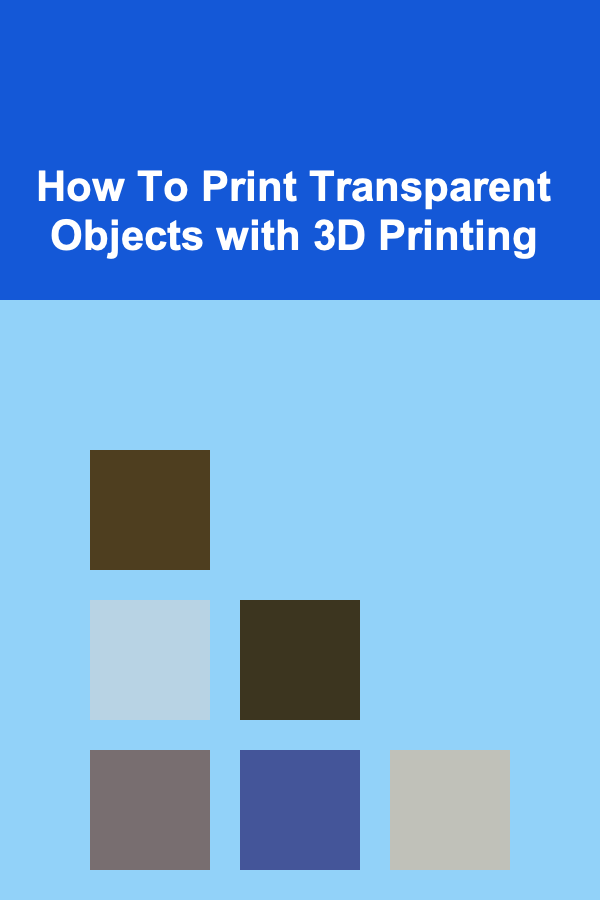
How To Print Transparent Objects with 3D Printing
ebook include PDF & Audio bundle (Micro Guide)
$12.99$9.99
Limited Time Offer! Order within the next:

3D printing has revolutionized the world of manufacturing, prototyping, and design, enabling the creation of objects that were previously difficult or even impossible to produce. One of the more challenging aspects of 3D printing is printing transparent objects. Transparency in 3D printing presents a unique set of challenges in terms of material selection, printing process, and post-processing techniques. This article will explore how to print transparent objects using 3D printing, covering the materials, technologies, challenges, and techniques involved in producing high-quality transparent prints.
Understanding Transparency in 3D Printing
Transparency in 3D printing refers to the ability of a printed object to allow light to pass through it, making it appear clear or translucent. Achieving high-quality transparent prints requires understanding how light interacts with the material, how the printing process affects the transparency, and how post-processing can improve the clarity of the final product.
There are different levels of transparency in 3D prints. Objects can be:
- Opaque: No light passes through.
- Translucent: Some light passes through, but the object remains partially cloudy.
- Transparent: The object is clear, and light passes through without significant distortion.
3D printing transparent objects is a multifaceted process that involves selecting the right materials, setting up the printer correctly, and sometimes applying post-processing techniques to enhance transparency. The results can vary depending on the type of printer and material used.
Materials for Printing Transparent Objects
To successfully print transparent objects, the choice of material is the most critical factor. Several materials are commonly used in 3D printing to achieve transparency, each with its own unique properties and challenges.
1. Acrylic (PMMA)
Acrylic, also known as PMMA (polymethyl methacrylate), is a popular material for achieving transparency in 3D prints. It is widely used in industries such as automotive, lighting, and architecture due to its optical clarity and strength.
- Advantages: Acrylic offers excellent optical clarity, UV resistance, and is easy to process post-printing. It's also affordable and can be produced in a variety of colors.
- Challenges: Printing with acrylic is not straightforward. It requires high precision, and printing too quickly or too slowly can result in defects. Additionally, PMMA can be brittle and prone to cracking when exposed to stress or impact.
2. Polycarbonate (PC)
Polycarbonate is another material that is commonly used for transparent 3D prints. Known for its high strength and impact resistance, polycarbonate can produce parts that are not only clear but also durable.
- Advantages: Polycarbonate offers high mechanical strength and heat resistance. It also has excellent optical clarity and is more impact-resistant than acrylic.
- Challenges: Polycarbonate requires higher extrusion temperatures and a heated print bed. It is more difficult to print than other materials, especially on FDM (Fused Deposition Modeling) printers, due to its high printing temperature and tendency to warp.
3. Transparent PLA (Polylactic Acid)
PLA is one of the most common materials used in 3D printing, and transparent PLA offers a relatively easy way to print objects with a degree of transparency. PLA is biodegradable and made from renewable resources, making it an environmentally friendly option.
- Advantages: Transparent PLA is easier to print than other transparent materials, and it is available in a variety of colors and shades of transparency. It works well with most desktop FDM printers.
- Challenges: While PLA is easy to print, the transparency is often not as clear as acrylic or polycarbonate. The resulting prints can be cloudy or have a frosted look rather than being fully transparent.
4. Resin for SLA (Stereolithography) Printing
For high-resolution transparent prints, resin used in SLA (Stereolithography) printing offers one of the best options. SLA printing uses a laser to cure liquid resin into solid layers, allowing for a very smooth and detailed finish.
- Advantages: SLA resin can achieve excellent transparency and surface finish. It is ideal for small, intricate parts that require high optical clarity.
- Challenges: SLA resins can be brittle, and the printing process is slower compared to FDM. Additionally, post-processing requires cleaning the printed object and curing it under UV light, which can be time-consuming.
5. Tritan™ Copolyester
Tritan™ is a copolyester material that offers a unique combination of transparency, strength, and durability. It is commonly used for producing clear plastic parts in the medical, food, and beverage industries.
- Advantages: Tritan™ copolyester is highly transparent, impact-resistant, and resistant to chemicals and UV light. It's an excellent option for creating functional, transparent parts that need to be both clear and tough.
- Challenges: Tritan™ is not as widely available as PLA or acrylic, and it can be more expensive. It also requires specialized printing equipment to achieve optimal results.
Choosing the Right 3D Printing Technology
The type of 3D printer you use plays a significant role in achieving transparency. There are various 3D printing technologies available, and some are better suited for printing transparent objects than others.
1. Fused Deposition Modeling (FDM)
FDM is one of the most common 3D printing methods. It works by melting a filament of material and extruding it through a nozzle to build up a part layer by layer. While FDM is an affordable and accessible technology, printing transparent objects with it can be challenging.
- Advantages: FDM printers are widely available, and the materials used (such as PLA) are relatively easy to work with. FDM printers can be a good option for low-cost transparent parts that don't require perfect clarity.
- Challenges: FDM prints tend to have visible layer lines, which can reduce the clarity of transparent prints. Warping and cracking can also be an issue when printing with materials like polycarbonate.
2. Stereolithography (SLA)
SLA uses a laser or projector to cure liquid resin layer by layer to create high-precision parts. SLA printing is an excellent choice for printing transparent objects with a high level of detail and smooth surface finishes.
- Advantages: SLA can produce extremely smooth and clear parts, making it the best choice for high-quality transparent prints. It is ideal for small, intricate items.
- Challenges: SLA requires a post-processing step to cure the resin fully, and the resins can be expensive. Additionally, the parts are often brittle and may not be as durable as FDM prints.
3. Selective Laser Sintering (SLS)
SLS uses a laser to fuse powdered material into solid layers. While SLS can be used with a variety of materials, it is less commonly used for transparent objects compared to FDM and SLA.
- Advantages: SLS can create parts with a high level of detail and strength. It's ideal for industrial applications that require durable parts.
- Challenges: SLS is typically not used for transparent prints, as the powder materials tend to create a rough surface finish, which impacts clarity.
Printing Transparent Objects: Key Considerations
When printing transparent objects, there are several factors to consider to achieve the best results.
1. Print Resolution
The resolution of the print will directly affect the transparency of the final product. Higher resolutions result in smoother layers, which can reduce the appearance of layer lines and improve clarity. Lower resolution prints may have visible defects that distort the transparency.
2. Layer Height
Layer height is another important factor when printing transparent objects. Smaller layer heights (such as 0.1mm or 0.2mm) can produce a smoother surface and better transparency, while larger layer heights may cause more visible lines and affect the light transmission.
3. Printing Speed
Printing too quickly can lead to poor layer bonding and reduce transparency. Slower printing speeds allow for better layer adhesion, leading to smoother surfaces and higher clarity. However, printing slowly also increases the print time, so balancing speed and quality is essential.
4. Temperature Settings
The temperature at which you print can also influence the transparency of the object. Printing at the optimal temperature for the material will ensure proper bonding between layers, which helps in achieving a clearer finish.
Post-Processing for Transparency
Post-processing is a crucial step in enhancing the transparency of 3D printed objects. The goal is to reduce the appearance of layer lines, smooth the surface, and improve the optical clarity of the object. Here are some common post-processing techniques for transparent prints:
1. Sanding
Sanding is one of the most common techniques for improving the clarity of 3D printed objects. Start with a coarse grit sandpaper and work your way up to finer grits, finishing with polishing compounds to achieve a smooth, clear surface.
2. Polishing
Polishing is the final step after sanding. A polishing compound or even a simple microfiber cloth can be used to buff the surface of the object to a clear finish. Be sure to use gentle pressure to avoid damaging the print.
3. Vapor Smoothing
For certain materials, vapor smoothing can be used to improve the transparency of the print. This involves exposing the object to a solvent vapor that softens the surface, allowing the layers to fuse and creating a smoother, more transparent finish.
4. UV Curing
UV curing can be used to further solidify resin prints, improving the surface finish and enhancing transparency. After printing, the object is exposed to UV light to cure the resin fully, which can reduce cloudiness and improve the overall clarity.
Conclusion
Printing transparent objects with 3D printing requires careful consideration of materials, printing technologies, and post-processing techniques. By selecting the right material and printer, adjusting settings for optimal resolution, and applying effective post-processing methods, you can achieve high-quality transparent prints. Whether you're using FDM, SLA, or another technology, the process of printing transparent objects is becoming increasingly accessible as 3D printing technologies evolve. Understanding these key considerations will allow you to create stunning transparent 3D printed objects with clarity and precision.

How to Add Accent Lighting to Elevate Your Home's Decor
Read More
How to Choose the Right Storage Solutions for Pet Supplies
Read More
How to Organize Your Makeup Collection by Category
Read More
How to Remove Grease and Grime from Kitchen Surfaces
Read More
Integrating Blockchain with IoT Devices: A Deep Dive
Read More
How to Optimize Your Soccer Nutrition for Peak Performance
Read MoreOther Products

How to Add Accent Lighting to Elevate Your Home's Decor
Read More
How to Choose the Right Storage Solutions for Pet Supplies
Read More
How to Organize Your Makeup Collection by Category
Read More
How to Remove Grease and Grime from Kitchen Surfaces
Read More
Integrating Blockchain with IoT Devices: A Deep Dive
Read More